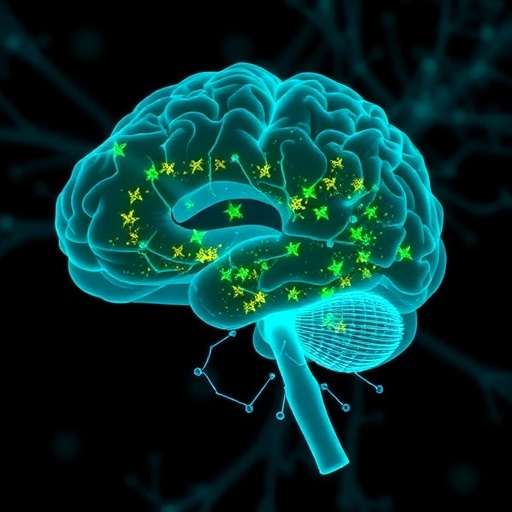In a groundbreaking study set to redefine our understanding of Alzheimer’s disease pathology, researchers have unveiled how different isoforms of the apolipoprotein E (APOE) gene distinctly influence the molecular architecture of human microglia within a living brain environment. This innovative research uses human microglia xenografted into mouse models of Alzheimer’s disease to explore the subtle yet powerful ways in which APOE variants modulate both gene expression patterns and epigenomic states, uncovering new layers of complexity in neurodegeneration.
Alzheimer’s disease—the most common cause of dementia—has long been associated with the APOE gene, of which three main isoforms (ε2, ε3, and ε4) exist. While APOE ε4 is a well-established genetic risk factor, the precise cellular and molecular mechanisms by which these isoforms shape disease pathology remained elusive until now. By leveraging cutting-edge transcriptomic and epigenomic profiling technologies, this investigation offers compelling insights into the differential reprogramming of microglia, the brain’s resident immune cells, which play critical roles in inflammation, synaptic pruning, and response to neurodegenerative damage.
The researchers transplanted human microglia bearing different APOE isoforms into a genetically engineered mouse model that harbors key features of Alzheimer’s pathology, including amyloid-beta accumulation and neuroinflammation. This xenograft approach bypasses the limitations of conventional rodent microglia, which do not fully replicate human disease features. Through advanced RNA sequencing and chromatin accessibility assays, the team mapped the transcriptome and epigenome landscapes, revealing isoform-specific molecular signatures that influence microglial function.
Remarkably, microglia carrying the APOE ε4 isoform displayed a distinct transcriptional program marked by elevated expression of genes involved in inflammatory responses, lipid metabolism, and phagocytic activity. This contrasted sharply with microglia harboring the ε3 isoform, which adopted a more homeostatic profile, emphasizing repair and maintenance functions. The ε2 isoform, considered protective against Alzheimer’s, drove yet another unique pattern characterized by enhanced anti-inflammatory gene expression and chromatin configurations favoring neuroprotective pathways.
At the epigenomic level, the study uncovered that APOE isoforms remodel the accessibility of regulatory DNA elements in microglia, shaping which genes can be turned on or off under disease conditions. APOE ε4 microglia demonstrated increased chromatin accessibility at enhancer regions controlling pro-inflammatory and neurotoxic genes, thereby potentiating harmful neuroimmune responses. Conversely, APOE ε2-associated microglia exhibited repressive chromatin marks in these regions, potentially blunting overactivation and supporting neuronal survival.
This granular molecular stratification has profound implications. It suggests that APOE not only sets the risk landscape for Alzheimer’s disease but also actively instructs microglial behavior via epigenetic reprogramming, influencing disease trajectory and severity. Such mechanistic resolution opens new avenues for therapeutic intervention focused on reshaping microglial epigenomes to mitigate neuroinflammation and neuronal damage.
Moreover, the use of a human-mouse chimeric platform represents a powerful model for exploring human-specific neuroimmune interactions that are otherwise inaccessible. By directly interrogating human microglia within a living brain environment, this approach provides unparalleled fidelity and translational relevance, accelerating the path toward precision medicine in neurodegenerative diseases.
The findings challenge prior assumptions that APOE isoforms merely modulate amyloid-beta clearance kinetics; instead, they reposition APOE as a master regulator of microglial gene regulatory networks and chromatin landscapes. Understanding how this regulation unfolds with aging and in response to pathological stimuli will be critical for designing isoform-specific therapies.
Additionally, the study’s integrative multi-omic methodology sets a new benchmark for neurobiology research. By combining transcriptomics with epigenomics in a cell-type specific and in vivo context, the investigators have charted a detailed molecular atlas of microglial states shaped by genetic risk factors—a crucial step toward unraveling Alzheimer’s heterogeneity.
Future research inspired by these insights could explore whether pharmacological agents or gene-editing tools can reverse APOE ε4-driven epigenetic changes, restoring protective microglial phenotypes. Such strategies may complement existing amyloid- or tau-targeting therapies to achieve holistic disease modification.
Furthermore, this research underscores the need to account for genetic diversity when evaluating patient responses to immunomodulatory treatments. Personalized approaches that consider APOE genotype could optimize therapeutic efficacy and minimize adverse effects linked to aberrant microglial activation.
In summary, this landmark study illuminates the intricate interplay between genetics, immune cell identity, and epigenetic regulation in Alzheimer’s disease. By revealing how distinct APOE isoforms sculpt the transcriptomic and epigenomic landscape of human microglia within a disease context, it lays the foundation for next-generation diagnostics and therapeutics tailored to microglial biology and genetic background.
As neurodegenerative disorders continue to pose immense challenges globally, such innovative research offers hope for more effective, targeted interventions that address the root causes of neuronal dysfunction. The discovery of APOE’s role in epigenetic modulation charts a promising path toward dissecting the complex molecular choreography underlying Alzheimer’s and potentially other neurodegenerative diseases.
With this new molecular blueprint in hand, researchers and clinicians are better equipped to disentangle the multifactorial nature of Alzheimer’s disease, moving closer to the elusive goal of prevention and cure. The nuanced understanding of APOE isoform-specific microglial dynamics opens exciting prospects for the field of neuroimmunology and precision neurology alike.
Subject of Research:
The differential impact of APOE isoforms on the transcriptomic and epigenomic states of human microglia xenografted into a mouse model of Alzheimer’s disease.
Article Title:
The APOE isoforms differentially shape the transcriptomic and epigenomic landscapes of human microglia xenografted into a mouse model of Alzheimer’s disease
Article References:
Murphy, K.B., Hu, D., Wolfs, L. et al. The APOE isoforms differentially shape the transcriptomic and epigenomic landscapes of human microglia xenografted into a mouse model of Alzheimer’s disease. Nat Commun 16, 4883 (2025). https://doi.org/10.1038/s41467-025-60099-4
Image Credits: AI Generated




